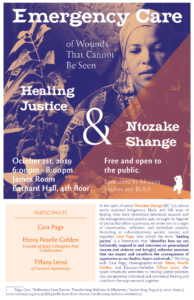Yesterday, October 1st, 2019, was one of the most unique experiences of my life. It is still hard to put it in to words, what I felt in Barnard’s James Room last night, but it was Shange. Is that possible? To use her name as an adjective? It was Shange. Healing Justice, in a way, is Shange and her work. That’s quite some pressure to put on a singular woman, though, but she is Shange. Last night, Ebony Noelle Golden described her as a “firestar” and a firestar, she is. Last night, the James Room was decolonized for two and a half hours. I was lucky enough to be in that room last night, where we were all invited to participate in ceremony, veneration, and prostration to Shange. I know myself to be a monotheist, but Shange is not short of a goddess. Perhaps, in some way, her spirit last night, was sharing energies with Sechita, and her ephemeral presence was felt. I was in a meditative state. I keep thinking zen, but that’s not the right word. It was meditative, perhaps, even religious. I am a person that believes in the exchange of energies, but is often skeptical of spirits. Perhaps it is my own fear? But yesterday, I spoke to Shange. I felt her there, and I was unafraid. My mind was white matter, white light, blank, and present. She granted me that gift–to be present. I felt myself, a different part of me wake up- Samaha Hossain.
I’m posting this almost a whole month after attending the healing justice event. I often write when I feel moved and I wrote that quickly one afternoon when I felt compelled to put my thoughts and feelings on paper. I made the decision to publish the unedited and unfiltered version of my thoughts about the Healing Justice event. I am inspired by Shange and her philosophy of dismantling and using the oppressive English language in ways that work best for our tongues and our bodies. The thoughts are above are my own, untouched by the conventions of academic expectations and without the pressure of explaining my feelings and consciousness to make sense to another. In essence, that night and being surrounded by Shange and her works granted me this feeling of entitlement and empowerment over my intellectual property. I have to say, there’s something quite satisfying about seeing your name follow a quote, it feels right.
As I conclude this post, I felt a lot that night. And something I have come to realize is that words won’t do it justice. It was an embodied and internalized experience. But it was one that made me think. It made me reach out to my mentors and loved ones who have supported me throughout my time at Barnard and reminded me to show them more love. It made me reconnect with my faith and want to explore different sects. We ended the ceremony that night in communal song. I remember swaying my body, closing my eyes, and basking in my presence of mind. But healing and song reminded me of the Sufi sect of Islam, which is different from what I practice. Sufism is the sect more involved with mysticism and music in prayer; the whirling dervishes of Turkey may be a popular representation of this. I bring this up because a Sufi song kept coming to mind as I sat through the ceremony. Kun Faya Kun is a Sufi song that was popularized by a Bollywood movie. I have attached the link below so that folks may listen, if they have the time. Kun Faya Kun translated from Arabic to English, means, “to be.” It means to exist and manifest oneself in the world as a being as per Allah’s will. To me, it also means to be present and conscious of your existence and the might of the universe, which I think fit perfectly with what I was feeling at the healing justice event.
As I stood in the shower that night, I put my phone by the window. I turned my volume on high, and hit play on Kun Faya Kun. I closed my eyes and swayed once more as the steam and droplets of water took over my body and filled my air with song and life. White light, blank space, my natural high. I felt it once more. I felt her and Him and myself.
Simply, I was.




